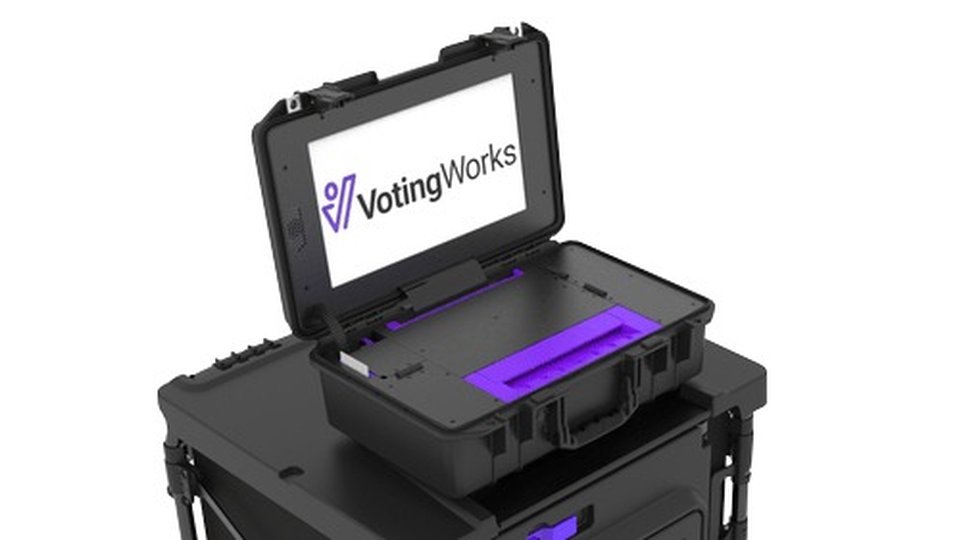Government
VotingWorks elects a winning solution

October 21, 2025 by Lisa Terry — Writer, FCL Components
More than half a million people step up during the typical American general election to perform an important but demanding job: serving as poll workers. A long day of answering questions and guiding voters culminates in a critical list of post-voting to-dos, including printing out, reading and signing off on vote tally sheets late in the night.
That's a problem, because these reports can be as long as 100 feet and printed on receipt paper the width of a typical CVS receipt. That makes them very difficult to read correctly during reporting and auditing — a particular issue given that the majority of poll workers are over the age of 60, according to Pew Research.
"It's been a long-standing pain point in election infrastructure, not only understanding the information that's presented on the receipt, but then also making that a public asset — these are posted on the walls at individual polling places to look at," says Matt Roe, Head of Product at VotingWorks, which designs and markets voting machines. The receipts must also be usable for auditing potentially years into the future, Roe adds.
Tackling the issue
Roe's company, VotingWorks, is a non-partisan, non-profit founded with a goal to create secure, affordable, open-source voting machines as an alternative to those produced by private companies. Being open source for every aspect of their products — software, hardware, documentation, and so on — is all about increasing public trust in voting equipment.
VotingWorks wanted to produce polling reports on 8-1/2x11-inch paper to make them far more readable and manageable. This meant that the printer needed to be incorporated into their ballot scanners, known as precinct scanners—the devices many voters feed their ballots into to officially cast their vote after marking them up by hand or with a ballot marking device.
An early proof-of-concept used an external printer that printed tallies on individual letter-sized paper sheets. The temporary solution was clunky, but the results were clear: 8-1/2x11 reports were a hit with poll workers and the jurisdictions that employ them.
"Our initial work in Mississippi showed that this is something that's really appreciated. It solves a lot of the pain points in terms of bringing transparency, auditability and simplicity into the tally reporting process," Roe says.
Regulatory and competitive requirements dictated that for the final design, the printer had to be incorporated into the device. As it sought out the right printer mechanism for the job, VotingWorks had several requirements:
- Uses a paper roll vs. individual sheets
- Small size and weight
- Affordable
- Reliable
- Embeddable
VotingWorks found the right fit with a locally available direct thermal printer mechanism. "Everything else that was really available missed the mark on at least one of those," says Roe.
The thermal printer manufacturers' engineers collaborated closely with VotingWorks to successfully integrate the printer mechanism into the VotingWorks precinct scanner. "It was super smooth sailing," Roe says. "They provided all the resources we needed to get this integrated as fast as possible."
VotingWorks also partnered with a paper provider offering a paper stock that ensures every page is smooth and flat after printing, despite coming off a roll.
Creating a true differentiator
VotingWorks' new precinct scanner with the 8-inch wide paper printing is proving very popular with election workers, simplifying their end-of-day reporting process and getting workers to bed earlier.
The product is already in use in New Hampshire and Mississippi, and is the process of gaining federal certification, a requirement for voting devices in many other states. Voting machine procurement is a careful, slow-moving, and highly regulated process.
"In every demonstration to any local election official in another state, this is something that is universally recognized and seen as a major improvement," says Roe. "Election administrators may be concerned about taking a bet on a new company and changing the incumbent model that they've been working with for the past 50 years. This is one of those things that does make a difference and may lead election administrators to buy something new on the basis of product differentiation."
Roe recommends other OEMs leave no stone unturned as they seek out just the right components for their needs — backed by people they enjoy working with. By doing so, VotingWorks managed to source a high-quality and durable printer mechanism to meet their exact requirements, Roe says. That helps them stand out in a deeply entrenched market so they can attract new customers and increase revenue.
"Although it is somewhat of a small feature to a casual observer, having a larger printout is something that has made a meaningful difference for election administrators — and our ability to sell this product," he says.
About Lisa Terry
Former RIS News Editor Lisa Terry is a seasoned B2B writer of articles, blogs, infographics, research reports, case studies, white papers and e-books, with a long list of media and technology clients. She has written for Harvard Business Review-AS, Hospitality Technology, RIS News, Advertising Age, Consumer Goods Technology, Inbound Logistics, Washington Technology and many others.






